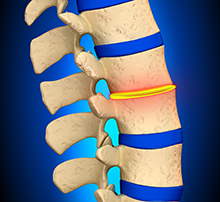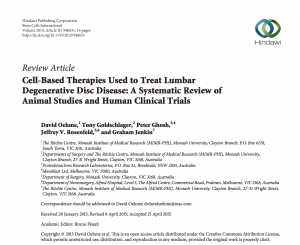Degenerative Disc Disease
Description:

Degenerative disc disease (DDD) is one of the most common causes of low back pain and neck pain. It describes the symptoms of pain and possibly radiating weakness or numbness stemming from a degenerated disc in the spine. Minor injuries to a disc may occur and not cause pain at the time of the injury. These repeated daily stresses and minor injuries can add up over time and begin to affect the discs. The disc eventually begins to suffer from the wear and tear, losing its water content gradually, thus the ability to act as a cushion. It begins to degenerate. When a disc degenerates, it loses its height, causing vertebrae to have less space in between, i.e disc space narrowing/collapse. This causes the openings (foramina) on each side of the vertebral column to get smaller, thus causing some pressure on the exiting spinal nerves. Bone spurs, osteophytes, may also begin to form around the disc space, causing more pressure
Symptoms:
As described before, DDD can cause pressure on the exiting spinal nerves, which may cause symptoms that are similar to those of a herniated disc, such as:
- Back or neck pain, depending on the location of the degeneration
- Shooting Pain radiating into legs or arms on one or both sides
- Numbness and/or tingling in arms and/or legs
- Muscle weakness and/or spasms in arms and legs normal activities and also minimize further degeneration
Causes:
- Genetics
- Aging process
- Trauma can also trigger DDD
- Obesity/ unhealthy life styles
Screening and Diagnosis:
Complete medical history and physical examination is key in the diagnosis of a bulging disc. X-ray, CT or MRI may be ordered for further evaluation.
Treatment:
Non-surgical options for facet joint pain include:
- Physical therapy
- Non-steroidal anti-inflammatory medications, muscle relaxants, and some cases pain medication.
Injection Therapy:
- Epidural steroid Injection, which can help decrease the inflammation of compressed spinal nerves, with proper management and physical therapy.
Goal of treatment is to decrease symptoms, such as pain, get back to normal activities and also minimize further degeneration.[/vc_column_text][/vc_column][vc_column width=”1/3″][vc_column_text]
Related Research Articles
Title: Cell-Based Therapies Used to Treat Lumbar Degenerative Disc Disease: A Systematic Review of Animal Studies and Human Clinical Trials
Authors: David Oehme, Tony Goldschlager, Peter Ghosh, Jeffrey V. Rosenfeld, and Graham Jenkin
Journal: Stem Cells International

